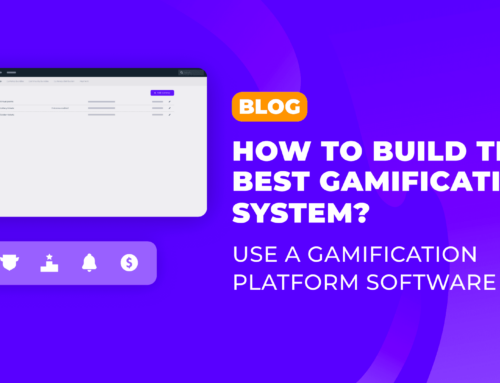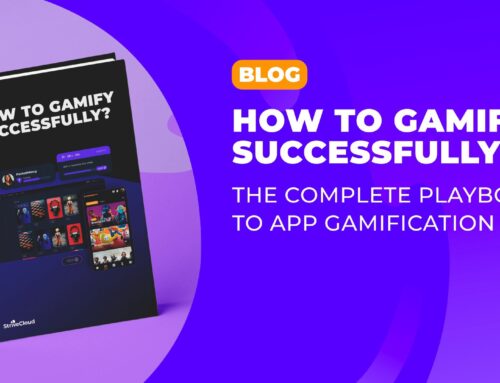How do popular health apps use feedback to boost user retention?
Is your mhealth app struggling to increase app engagement? Every day more mhealth alternatives are coming up. When you keep in mind the average person only uses around 40 apps per month, it’s hard to earn your spot in that place. In fact, after 90 days of downloading a mhealth app, only 10% of users remain. Focusing on user acquisition at this point is like filling a leaky bucket.
Additionally, over 50% of patients with chronic diseases don’t follow their prescribed treatment. Mhealth apps need to provide an environment where the patient is motivated to work towards improving their health. To increase user retention and engagement on your mhealth app, you need to create an enjoyable and user-friendly experience.
In this article, we’ll show you how gamification for apps can help you boost user retention and app engagement.
Here’s what we’ll cover:
Gamification for health apps – why, how & what?
What is gamification for apps?
Gamification for apps is the usage of game elements and psychology to make your app more sticky and engaging. Adding a layer of gamification to your app enriches your user experience with fun elements. It makes the app more enjoyable to use and often leads to increased user retention.
When you use gamification for apps correctly, you can drive any user behavior you’d like. Having trouble collecting the right data? Link challenges and rewards to data collection! Is your user not moving forward? Add visual feedback like points or progress bars to boost their motivation! Gamification for health can mean motivating fitness, diet, blood testing… all in a user-friendly way!
How does gamification for health work?
As a mhealth app, you want your user to be in control. Your job exists out of facilitating the user and giving them the right motivations to go after their health goals. Through gamification for apps, you can tie rewards to that goal, to reinforce the user taking action.
For instance, let your user collect coins for completing necessary actions. Or show them their progress with visual indicators such as a progress bar or statistics. These elements are a way of giving feedback to your user. It shows them they’re on the right path to completing their goals, or how far they’ve already come. Not only does instant feedback increase app engagement, but it motivates the user to keep going.
Besides the positive feeling of making progress, users will also continue on their quest as a way to avoid losses. The fear of losing something, or missing out on an opportunity is innate in humans. So if the reward of making progress isn’t good enough, you can still threaten to take something away. A lot of apps do this by rewarding “daily streaks”. For example, once people have built up 100 consecutive days of logging in, losing it is just not worth it.
How to drive user progress & retention with gamification for health apps
Providing users with real-time feedback can boost their motivation. Visualizing how much closer a user gets to their goal, creates a desire to complete that goal. Who doesn’t like to see their progress instantly?
You can drive user progress in many different levels, and in various ways. We listed some of the great ones here for you:
Progress bar
A progress bar is a technique used in gamification for apps, where users get to see how far they are from completing a goal. The great thing is users always stay focused on the next goal, and keep on moving forward. That’s because our brain hates leaving a task unfinished. Incompleteness causes stress. To relieve that feeling we complete the task at hand and get rewarded with endorphins in the brain.
A progress bar motivates users to complete their profiles or finish a task from start to finish. Let’s be honest, if you abandon a task within an app, you’re not coming back to it. Usually, the progress bar only appears once the first actions have already been taken. This way the user gets a ‘head start’, and they don’t have to start from scratch.
Points collection
Points are another progress indicator that often leads up to a particular objective. Give the user points for every action they complete. Once they gain enough points you can do a lot with it. Let them redeem points for actual prizes, unlock new things in your app, or just level up their profile.
Points reward users for app engagement. They see the immediate progress from their actions. For everything you do, you receive your points as a reward. For instance, gamification for health can reward users with points every time they eat healthily, drink enough water or have enough physical activity.
Leveling system
The greatest indicator of how engaged your users are is what level they’re on. You can set up a custom leveling system that rewards the behaviors you want to see. Usually, a user levels up based on the number of points they’ve collected.
A leveling system is great for long-term app engagement and user retention. The higher level a user gets, the more engaged they will be. A leveling system shows the user how far they’ve already come. Additionally, they can unlock a bunch of new challenges or rewards every time they level up.
Contextual notifications
Notifications are a fast way of giving feedback to encourage good user behavior or correct wrong behaviors. It’s easy to include an encouraging message when your user completed a workout on your app or completed their daily blood testing. Every time a user gets a new achievement or unlocks a milestone you can suggest the next steps to take. This way you eliminate confusion and boost app engagement.
Some mhealth apps like mySugr focused on diabetes management use notifications to remind regular blood testing. It shows an increase of 44% in-app engagement and leads to less churn.
Here’s what gamification for health looks like
Zamzee uses feedback to motivate movement with children
Zamzee is an activity tracker for children. It has a rewards system in place that reinforces movement. The kids can collect points by moving and completing challenges. They can exchange these points for virtual rewards such as equipment for their avatars or actual physical rewards.
Kids using Zamzee are almost 60% more active than other kids. Additionally, healthcare providers can measure the progress of their patients as well, and make recommendations to do even better!
How Happify uses gamification for apps to improve mental health
Happify is a mental health app focused on improving the emotional well-being of its users. It’s mostly centered around overcoming stress and anxiety and the negative impact it has on people’s lives. The app has over 30 tracks where users can make progress and learn skills to be more resilient.
Needless to say, each track is based on scientific research from neuroscientists and psychologists. Users can track the progress they’re making on every track, as well as general stats on their happiness, life satisfaction, and positive emotion. After only six to eight weeks, a stunning 86% of users state they feel much happier and better.
They call it the digitization of cognitive-behavioral therapy. Gamification for health changes the effective, but boring treatment into a fun long-term solution. Other game elements in Happify are achievements like gold or silver medals, and more!
Recap
Mhealth apps have the power to provide personalized treatments or health coaching at scale. For patients, this means they can be more autonomous and are put in charge of their own health. Unfortunately, over half of all people will skip their treatments due to low motivation. The healthcare ritual often feels like a strain, and after 90 days only about 10% of users are still engaged.
With gamification for apps, you can turn those boring treatments into a fun and engaging experience! You can drive user progress with game elements such as points, leveling systems, and progress bars. By rewarding the behaviors you want to see, you can boost app engagement by up to 44%! Gamification for apps seems to be the future, and present for the most popular mhealth apps in the world.


